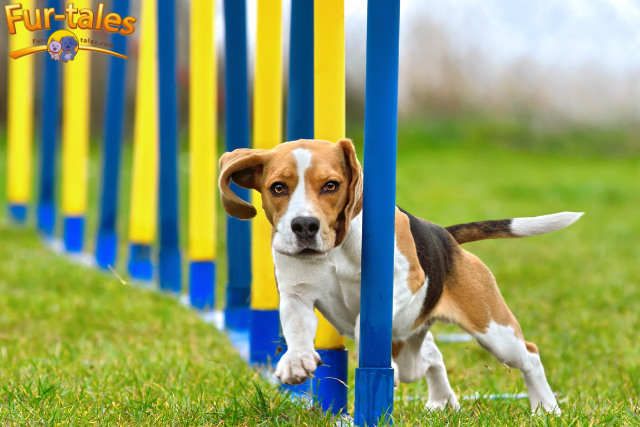
The Benefits of Canine Agility Training: Exercise and Fun
Dogs are natural athletes. Whether they are chasing a ball, running in the yard, or exploring a hiking trail, movement is part of their joy. However, beyond everyday play, there is one activity that can elevate both their physical and mental well-being to the next level — canine agility training.
Agility training is more than just an exciting sport. It offers an enriching combination of physical exercise, mental stimulation, and bonding opportunities. From weaving through poles to jumping hurdles and sprinting through tunnels, agility courses challenge dogs to use their bodies and minds in harmony.
Whether your dog is a playful puppy, an energetic adolescent, or a seasoned adult, agility training can provide benefits for dogs of all ages and breeds. In this article, we’ll explore the benefits of canine agility training, why it is an excellent addition to your dog’s routine, and how to get started.
What is Canine Agility Training?
Canine agility is a fast-paced dog sport where dogs navigate a course filled with various obstacles. These typically include:
Jumps
Tunnels
Weave poles
A-frames
Dog walks
Seesaws
Handlers direct their dogs through the course using verbal cues, hand signals, and body language. The goal is to complete the course quickly and accurately. While competitive agility is popular worldwide, many pet owners participate simply for exercise and fun rather than trophies and titles.
The Physical Benefits of Agility Training
1. Keeps Dogs Fit and Healthy
One of the most obvious benefits of agility training is physical exercise. Running, jumping, climbing, and weaving provide a full-body workout that improves:
Cardiovascular health
Muscle strength and endurance
Flexibility and coordination
Joint and bone health
Agility is especially helpful for active breeds that need more than a daily walk to stay healthy and happy.
2. Helps Manage Weight
Obesity is a growing concern for pets, especially in dogs. Extra weight can lead to serious health problems, including diabetes, joint issues, and reduced lifespan.
Agility training burns calories and builds lean muscle mass, helping dogs maintain an ideal weight. When combined with a balanced diet, it’s an effective strategy for weight management.
3. Supports Joint and Bone Health
Controlled physical activity, like that in agility courses, helps keep joints flexible and strengthens bones. Regular exercise also reduces the risk of age-related issues such as arthritis.
For young dogs, agility promotes healthy growth, while for seniors, it helps maintain mobility and delay the onset of stiffness.
The Mental Benefits of Agility Training
1. Boosts Cognitive Function
Agility training is not just about physical movement — it also challenges a dog’s mind. Learning how to navigate courses, respond to cues, and solve problems stimulates cognitive function.
This mental workout can help prevent boredom, reduce anxiety, and keep dogs sharp as they age.
2. Improves Focus and Impulse Control
Navigating an agility course requires concentration and obedience. Dogs learn to focus on their handlers, ignore distractions, and wait for instructions before acting.
This increased impulse control can transfer to other areas of life, making agility-trained dogs more well-mannered in everyday situations.
3. Reduces Behavioral Issues
Many behavioral problems in dogs stem from boredom and excess energy. Agility provides an outlet for this energy, reducing destructive behaviors like chewing, digging, and excessive barking.
Dogs who are mentally and physically satisfied are typically calmer and happier at home.
The Emotional and Social Benefits of Agility Training
1. Strengthens the Bond Between Dog and Owner
Agility is a team sport. Success depends on communication, trust, and cooperation between dog and handler.
Working together in a positive and supportive environment strengthens the bond between you and your dog. This connection extends beyond the agility field and enhances your everyday relationship.
2. Builds Confidence
For shy or anxious dogs, agility training can be transformative. As they learn new skills and overcome obstacles, their confidence grows.
Completing courses and receiving praise and rewards helps dogs feel accomplished and secure, boosting their overall sense of well-being.
3. Provides Social Opportunities
Agility classes and competitions are social events. Dogs get to interact with other dogs, and owners meet like-minded pet lovers. This exposure helps dogs develop better social skills and reduces fear or reactivity in new environments.
Is Agility Training Right for Every Dog?
While agility training offers many benefits, it’s important to consider your dog’s age, health, and temperament before starting.
Young Dogs
Puppies can begin foundation training focused on body awareness, basic obedience, and low-impact obstacles. However, they should not engage in high jumps or strenuous activities until their growth plates close.
Adult Dogs
Healthy adult dogs are ideal candidates for agility. Consult your veterinarian to ensure your dog is fit for this level of exercise.
Senior Dogs
Older dogs can still enjoy agility with modifications. Lower jumps, slower speeds, and tailored exercises keep them active without strain.
Shy or Fearful Dogs
Agility can help build confidence, but it should be introduced slowly and positively. Forcing a nervous dog can backfire, so patience and encouragement are key.
How to Get Started with Agility Training
Starting agility does not require entering competitions or building a professional course in your backyard. You can begin with simple steps at home or in a local class.
Enroll in a beginner agility class for guided instruction
Use household items (like broomsticks for jumps or cones for weaving) to create simple obstacles
Focus on basic obedience and body awareness
Keep sessions short, fun, and positive
Reward your dog with treats, praise, and play
Always prioritize safety. Avoid hard surfaces, ensure proper warm-ups and cool-downs, and consult your veterinarian if your dog has any health concerns.
FAQs About Canine Agility Training
Q1: At what age can my dog start agility training?
Puppies can begin foundational work as early as 8 weeks old, but they should not perform jumps or high-impact activities until at least 12 to 18 months of age.
Q2: Do all dogs enjoy agility training?
While many dogs love the challenge and fun of agility, it’s not for every dog. Each dog has individual preferences and abilities. Always respect your dog’s comfort level.
Q3: Can small or large breeds participate in agility?
Yes. Agility is for dogs of all sizes and breeds. Obstacles can be adjusted to suit the needs of smaller or larger dogs.
Q4: Is agility training safe for senior dogs?
With modifications, senior dogs can benefit from agility. Focus on low-impact activities and consult your veterinarian before starting.
Q5: Do I need special equipment to start agility training?
Not at first. You can begin with basic household items or attend a class with provided equipment. If you decide to continue, there are affordable starter kits available.
Image Designed Using Canva
